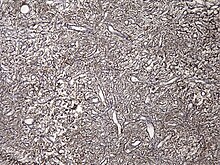Infantile hemangiopericytoma
| Infantile hemangiopericytoma | |
|---|---|
| Other names | Congenital hemangiopericytoma |
 | |
| Haemangiopericytoma | |
| Specialty | Dermatology |
Infantile hemangiopericytoma is a cutaneous condition characterized by single or multiple dermal and subcutaneous nodules that may be alarmingly large at birth or grow rapidly.[1][2]
Signs and symptoms
[edit]Like juvenile hemangiomas, infantile hemangiopericytomas only appear in the subcutis and affect newborns throughout their first year of life. They are characterized by being multilobulated and frequently having separate perivascular and intravascular satellite nodules outside of the main tumor mass.[2] Although there have been reports of numerous lesions,[3][4] the majority of lesions are solitary.[5] The lower extremities, particularly the thigh, pelvic fossa, and retroperitoneum, are where tumors are most frequently found. Less frequently, it affects the upper extremities and trunk. Most are located in muscular tissue and are deep entrenched.[2] There are reports of lesions in the tongue and sublingual area that are present from birth.[6]
Diagnosis
[edit]Histology must be used to make the diagnosis because the tumor may be hard to differentiate from other neoplasms with similar characteristics.[7] Histologically, hemangiopericytoma is characterized by staghorn-shaped blood vessels and sponge-like sinusoidal vasculature that are randomly linked and encircled by ovoid, short spindle-shaped cells.[8] CD34 positive has a high immunohistochemical correlation with hemangiopericytoma.[9]
Other pediatric tumors such tufted angioma, pyogenic granuloma, infantile hemangioma, kaposiform hemangioendothelioma, and angiosarcoma should be taken into consideration in the differential diagnosis.[8][10]
Treatment
[edit]Conservative surgery is the best course of action. The preferred method is wide local excision. Chemotherapy is thought to be the next line of treatment for lesions that cannot be removed. When chemotherapy and surgery fail, radiotherapy should be the last resort.[11]
See also
[edit]References
[edit]- ^ Rapini, Ronald P.; Bolognia, Jean L.; Jorizzo, Joseph L. (2007). Dermatology: 2-Volume Set. St. Louis: Mosby. ISBN 978-1-4160-2999-1.
- ^ a b c SINGH, VP; MUKHOPADHYAY, HG; KANNAN, N; LAKHTAKIA, R; CHOUDHURY, JC; BHOPTE, AG (1995). "Infantile Hemangiopericytoma". Medical Journal Armed Forces India. 51 (2). Elsevier BV: 136–137. doi:10.1016/s0377-1237(17)30948-6. ISSN 0377-1237. PMC 5529909.
- ^ Sl, Kauffman (1960). "Hemangiopericytoma in children". Cancer. 13 (4): 695–710. doi:10.1002/1097-0142(196007/08)13:4<695::aid-cncr2820130409>3.0.co;2-9. ISSN 0008-543X. PMID 14404845. Retrieved 2024-05-19.
- ^ Seibert, Joanna J.; Seibert, Robert W.; Weisenburger, Dennis S.; Allsbrook, William (1978). "Multiple congenital hemangiopericytomas of the head and neck". The Laryngoscope. 88 (6). Wiley: 1006–1012. doi:10.1288/00005537-197806000-00012. ISSN 0023-852X. PMID 651500.
- ^ Enzinger, Franz M.; Smith, Bruce H. (1976). "Hemangiopericytoma". Human Pathology. 7 (1). Elsevier BV: 61–82. doi:10.1016/s0046-8177(76)80006-8. ISSN 0046-8177. PMID 1244311.
- ^ Alpers, Charles E.; Rosenau, Werner; Finkbeiner, Walter E.; De Lorimier, Alfred A.; Kronish, Daniel (1984-03-01). "Congenital (Infantile) Hemangiopericytoma of the Tongue and Sublingual Region". American Journal of Clinical Pathology. 81 (3). Oxford University Press (OUP): 377–382. doi:10.1093/ajcp/81.3.377. ISSN 1943-7722. PMID 6702731.
- ^ Michael, Kim; Eikmeier, April; Mueller, Virginia (2010). "Infantile Hemangiopericytoma". Journal of Diagnostic Medical Sonography. 26 (4): 198–201. doi:10.1177/8756479310374359. ISSN 8756-4793.
- ^ a b Boynuyogun, Etkin; Calis, Mert; Kavuncuoglu, Altan; Kosemehmetoglu, Kemal; Tuncbilek, Gokhan (2021-09-03). "Presentation of Infantile Hemangiopericytoma/Solitary Fibrous Tumor as a Giant Extracranial Temporal Mass". Fetal and Pediatric Pathology. 40 (5): 523–527. doi:10.1080/15513815.2020.1716904. ISSN 1551-3815.
- ^ Espat, N. Joseph; Lewis, Jonathan J.; Leung, Denis; Woodruff, James M.; Antonescu, Christina R.; Shia, Jingu; Brennan, Murray F. (2002-10-03). "Conventional hemangiopericytoma". Cancer. 95 (8). Wiley: 1746–1751. doi:10.1002/cncr.10867. ISSN 0008-543X. PMID 12365023.
- ^ Sulit, Daryl J.; Tom, Wynnis L.; Willert, Jennifer R.; Nespeca, Mark P.; Friedlander, Sheila Fallon (2011). "Multicentric Infantile Hemangiopericytoma". Journal of Pediatric Hematology/Oncology. 33 (4). Ovid Technologies (Wolters Kluwer Health): e166–e170. doi:10.1097/mph.0b013e3182145627. ISSN 1077-4114. PMID 21516017.
- ^ Virden, Charles P.; Lynch, Frank P. (1993). "Infantile hemangiopericytoma: A rare cause of a soft tissue mass". Journal of Pediatric Surgery. 28 (5). Elsevier BV: 741–743. doi:10.1016/0022-3468(93)90047-o. ISSN 0022-3468. PMID 8340873.
Further reading
[edit]- Pérez, Alba; Vigil, Sara; Pescador, Isabel; Fernández, Beatriz; Jiménez, Lidia; Agra, Carolina; de Rojas, Teresa; Sánchez-Luna, Manuel (2018-01-04). "Infantile hemangiopericytoma leading to hypovolemic shock in a neonate". Pediatric Blood & Cancer. 65 (5). Wiley. doi:10.1002/pbc.26950. ISSN 1545-5009. PMID 29314578.
- Futagami, A.; Aoki, M.; Iwakiri, I.; Hyakusoku, H.; Kawamoto, M.; Kawana, S. (2006). "Infantile Hemangiopericytoma – Case Report and Literature Review". Pediatric Dermatology. 23 (4): 335–337. doi:10.1111/j.1525-1470.2006.00263.x. ISSN 0736-8046. PMID 16918627.
